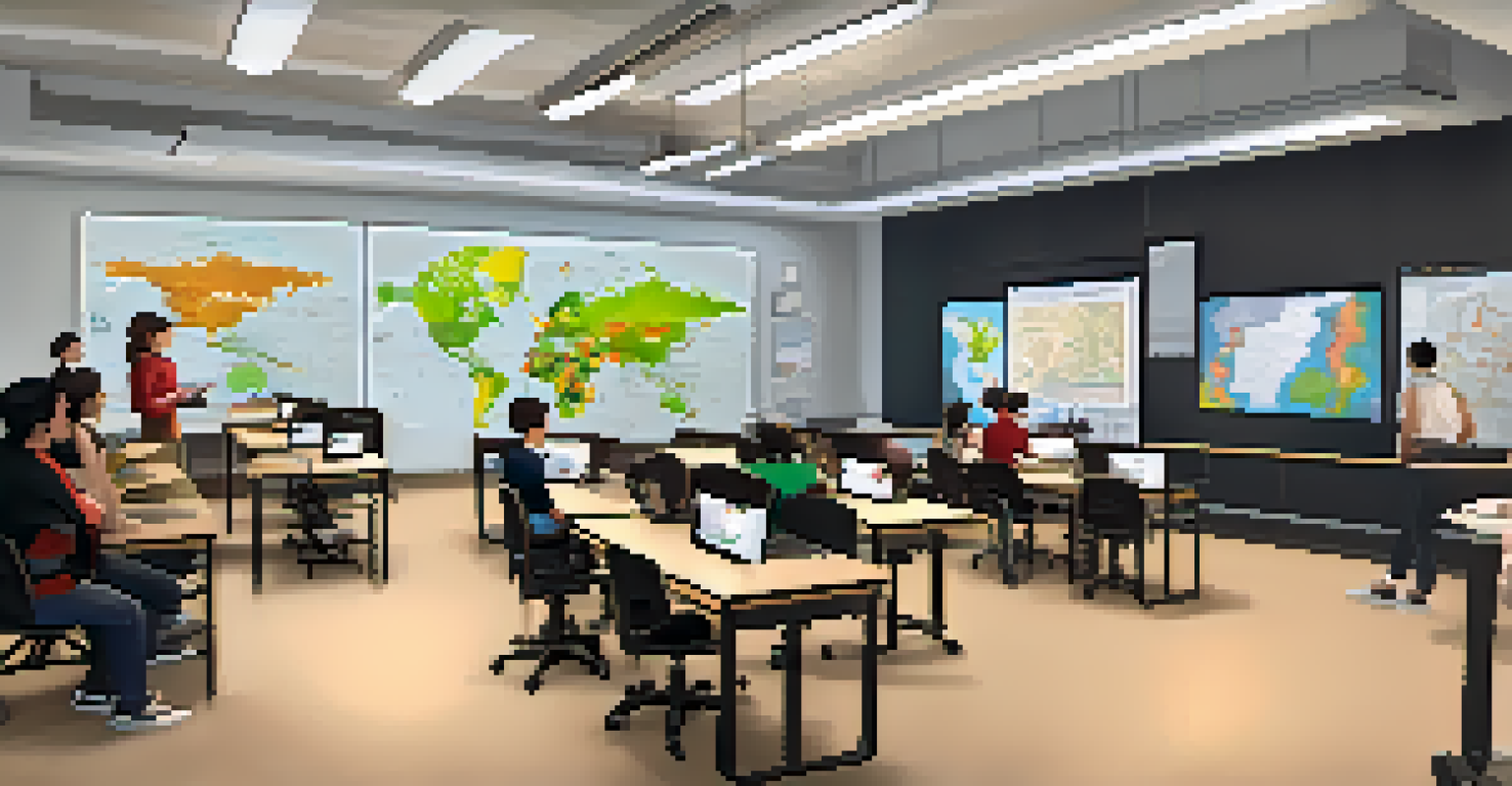Cross-Disciplinary Learning: Breaking Down Educational Silos

Understanding Cross-Disciplinary Learning in Education
Cross-disciplinary learning is an approach that integrates knowledge and methods from different disciplines. It encourages students to make connections between subjects, fostering a deeper understanding of concepts. Instead of viewing subjects in isolation, this method helps learners see the bigger picture, enhancing critical thinking and creativity.
Education is not the filling of a pail, but the lighting of a fire.
For instance, a project that combines science and art can spark students' imaginations while teaching them about both fields. When students create a visual representation of a scientific concept, they not only grasp the science better but also develop artistic skills. This holistic approach can lead to richer educational experiences.
As educational systems evolve, embracing cross-disciplinary learning can break down the rigid walls that often limit students' potential. By promoting collaboration and integration, we prepare learners for a world that increasingly values versatility and adaptability in various fields.
The Benefits of Breaking Down Educational Silos
Breaking down educational silos allows for a more integrated learning experience. Traditional education often compartmentalizes subjects, leading to a disjointed understanding of knowledge. By merging disciplines, educators can create more engaging and relevant learning experiences for students.

Consider the example of environmental science, which naturally intersects biology, chemistry, and social studies. By exploring environmental issues through multiple lenses, students can better appreciate the complexity of real-world problems. This interconnected approach not only enriches learning but also fosters empathy and awareness.
Embrace Cross-Disciplinary Learning
Integrating knowledge from various subjects enhances critical thinking and creativity in students.
Moreover, cross-disciplinary learning encourages teamwork and communication, essential skills in today’s collaborative work environments. When students work on projects that require input from various fields, they learn to appreciate different perspectives, preparing them for future professional challenges.
Implementing Cross-Disciplinary Learning in Classrooms
Implementing cross-disciplinary learning requires thoughtful planning and collaboration among educators. Teachers can start by identifying common themes or problems that span multiple subjects. For example, a unit on climate change can include science, math, and even literature, allowing students to explore the topic from different angles.
The beautiful thing about learning is that no one can take it away from you.
Additionally, teachers can create interdisciplinary projects that encourage students to apply knowledge from various fields. Group activities, presentations, and research projects can all incorporate multiple disciplines, making learning more dynamic and interactive. This hands-on approach fosters a sense of ownership and engagement among students.
Professional development for educators is also crucial in this process. Training sessions and workshops that emphasize the importance of cross-disciplinary learning can equip teachers with the necessary skills and strategies to integrate this approach effectively.
Challenges of Cross-Disciplinary Learning
While cross-disciplinary learning offers numerous benefits, it also presents unique challenges. One significant hurdle is the traditional mindset of educators and institutions that prioritize subject-specific teaching. Changing this mindset requires time, patience, and a willingness to embrace new ideas.
Additionally, curriculum constraints can limit the ability to integrate disciplines effectively. Many schools follow rigid standards that focus on specific subjects, making it difficult for educators to implement cross-disciplinary strategies. Flexibility in curriculum design is essential to support this innovative approach.
Break Educational Silos
Merging disciplines fosters a more engaging and relevant learning experience, preparing students for real-world challenges.
Lastly, assessment methods must evolve alongside teaching strategies. Standardized tests often measure knowledge in isolation, not reflecting students' abilities to connect ideas across disciplines. Developing new assessment models that value interdisciplinary skills is crucial for fostering a truly integrated learning environment.
Real-World Examples of Cross-Disciplinary Learning
Many educational institutions are already successfully implementing cross-disciplinary learning. For example, project-based learning initiatives in schools have combined subjects like math, science, and history to tackle real-world issues. These projects not only engage students but also prepare them for future challenges by developing critical thinking skills.
Universities are also embracing this approach, offering programs that blend technology with the arts. Students might learn coding while also exploring graphic design, equipping them with diverse skills for a competitive job market. Such programs illustrate how cross-disciplinary learning can enhance creativity and innovation.
Furthermore, organizations like STEM schools focus on integrating science, technology, engineering, and math with the arts and humanities. This holistic approach not only enriches students' educational experiences but also prepares them to thrive in a rapidly changing world.
The Role of Technology in Cross-Disciplinary Learning
Technology plays a pivotal role in facilitating cross-disciplinary learning. Digital tools allow students to collaborate on projects across various disciplines, breaking down geographical and institutional barriers. Online platforms can host discussions, share resources, and manage group work, making it easier to engage with diverse subjects.
Moreover, technology enhances access to information and learning resources. Students can explore topics through interactive simulations, virtual reality experiences, and online courses that span multiple fields. This exposure broadens their understanding and encourages them to think critically about complex issues.
Technology Enables Collaboration
Digital tools facilitate cross-disciplinary projects, enhancing access to information and promoting teamwork among students.
As educators integrate technology into their teaching practices, it's essential to provide guidance to students on how to navigate these tools effectively. Teaching digital literacy skills ensures that students can use technology to support their cross-disciplinary learning endeavors meaningfully.
Future Perspectives on Cross-Disciplinary Learning
Looking ahead, cross-disciplinary learning is poised to become an essential aspect of education. As the world becomes increasingly interconnected, the need for individuals who can think across disciplines will only grow. Educational systems that prioritize this approach will better prepare students for future challenges and opportunities.
Furthermore, the rise of global issues—such as climate change, public health, and social justice—demands collaborative solutions that draw on multiple fields. Encouraging students to engage with these complex problems through cross-disciplinary learning will cultivate a generation of innovative thinkers and problem solvers.

Ultimately, the future of education lies in breaking down silos and fostering an environment where students can explore, create, and collaborate. By embracing cross-disciplinary learning, we can empower learners to thrive in an ever-evolving world, equipped with the skills to make meaningful contributions across various domains.